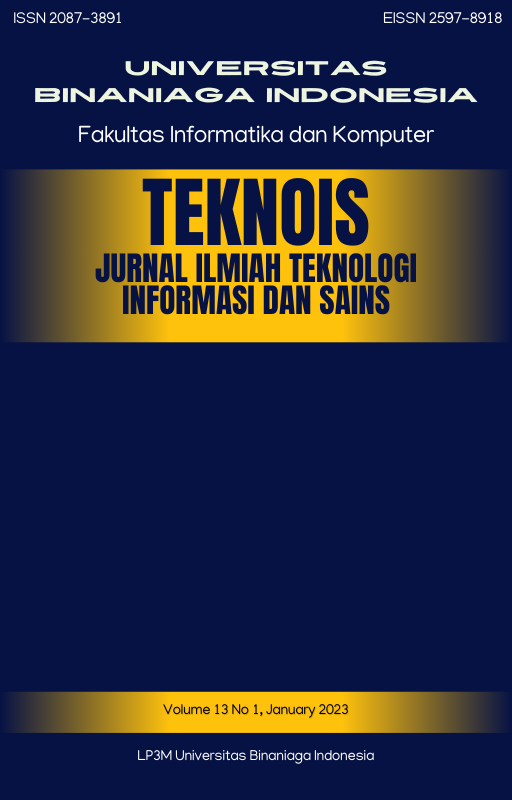Penerapan Information Gain Dan Algoritma K-Means Untuk Klasterisasi Kedisiplinan Pegawai Menggunakan Rapidminer
DOI:
https://doi.org/10.36350/jbs.v13i1.165Keywords:
information gain, disiplin, rapidminer, k-means, davies bouldin index (DBI)Abstract
One aspect of the discipline of an employee in an agency can be seen from the side of attendance. The level of employee attendance is closely related to an employee's disciplinary assessment. The level of employee discipline can be seen by looking at the hours of attendance or check in attendance, so that with these parameters you will get early, on time and late entry. This study explores data on attendance by using the k-means clustering algorithm. Before calculating the k-means clustering algorithm, attribute selection using information gain is expected to reduce attributes with small weights. The calculations are performed using Rapidminer software. The results showed that the attribute that had the greatest influence was the percentage of late entry with a weight of 0.783. Clustering using the k-means algorithm produces three clusters with the performance value of the Davies Bouldin Index (DBI) -0.645. Cluster zero has fifteen members, cluster one has thirty-six members, and cluster two has fifty-two members. Cluster zero is a cluster that has a low level of discipline, cluster one is a cluster that has a high level of discipline, while cluster two is a cluster that has a moderate level of discipline.Downloads
References
D. H. Murti, N. Suciati, and D. J. Nanjaya, Clustering Data Non-Numerik Dengan Pendekatan Algoritma K-Means Dan Hamming Distance Studi Kasus Biro Jodoh, JUTI J. Ilm. Teknol. Inf., vol. 4, no. 1, p. 46, 2005, doi: 10.12962/j24068535.v4i1.a245.
Dio Prima Mulya, Analisa Dan Implementasi Association Rule Dengan Algoritma Fp-Growth Dalam Seleksi Pembelian Tanah Liat, Teknol. dan Sist. Inf. Bisnis, vol. 1, no. 1, pp. 4757, 2019.
Kusrini and E. T. Luthfi, Algoritma Data Mining, 1st ed. Yogyakarta: C.V ANDI OFFSET, 2009.
M. L. Sibuea and A. Safta, Pemetaan Siswa Berprestasi Menggunakan Metode K-Means Clustring, Jurteksi, vol. 4, no. 1, pp. 8592, 2017, doi: 10.33330/jurteksi.v4i1.28.
R. K. Dinata, H. Novriando, N. Hasdyna, and S. Retno, Reduksi Atribut Menggunakan Information Gain untuk Optimasi Cluster Algoritma K-Means, J. Edukasi dan Penelit. Inform., vol. 6, no. 1, p. 48, 2020, doi: 10.26418/jp.v6i1.37606
Suyanto, Data Mining Untuk Klasifikasi dan Klasterisasi Data, 1st ed. Bandung: INFORMATIKA BANDUNG, 2019.
U. Udayana et al., Seleksi Fitur Dalam Klasifikasi Genre Musik, J. Ilmu Komput., vol. 10, no. 1, pp. 1926, 2018.
Y. R. Sari, A. Sudewa, D. A. Lestari, and T. I. Jaya, Penerapan Algoritma K-Means Untuk Clustering Data Kemiskinan Provinsi Banten Menggunakan Rapidminer, CESS (Journal Comput. Eng. Syst. Sci., vol. 5, no. 2, p. 192, 2020, doi: 10.24114/cess.v5i2.18519.
Suraya, G. Wijayanto, A. (2022). "Comparison of Hierarchical Clustering, K-Means, K-Medoids, and Fuzzy C-Means Methods in Grouping Provinces in Indonesia according to the Special Index for Handling Stunting", Indonesian Journal of Statistics and Its Applications, VOl 6 No 2. Agustus 2022
Syukron, H. Fayyad, M. Fauzan, F. Ikhsani, Y. Gurning, U. (2022). "Perbandingan K-Means K-Medoids dan Fuzzy C-Means untuk Pengelompokan Data Pelanggan dengan Model LRFM", Malcom: Indonesian Journal of Machine Learning and Computer Science, Vol 2 No 2. September 2022
Awaludin, M. (2019). "PENERAPAN ALGORITMA K-MEANS CLUSTERING PADA K-HARMONIC MEANS UNTUK SCHEDULE PREVENTIVE MAINTENANCE SERVICE", JSI (Jurnal sistem Informasi) Universitas Suryadarma, Vol 6 No 1, Januari 2019









